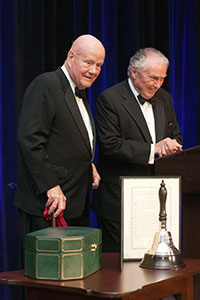Page content
Message from the President
Vision and Generosity
To better know patriots past, we rely upon the generosity of patriots present. Fortunately, The Colonial Williamsburg Foundation is blessed with such friends as Forrest E. Mars Jr., who, for twenty-five years, has supported our efforts to deepen public understanding of our nation’s beginnings, of the courage and resolve of those early patriots. His commitment to this noble mission led the foundation’s trustees to bestow their highest award, the Churchill Bell, on Mr. Mars “in recognition of extraordinary civic leadership and national service.”
Emblemized by a handmade, silver town crier’s bell, the honor echoes the foundation’s 1955 presentation of the Williamsburg Award to Sir Winston Churchill in recognition of his World War II leadership in the defense of liberty. Today’s Churchill Bell, linking past to present, recognizes leadership, service, and stewardship in advancing the ideals of liberty, courage, devotion to the dignity of the individual, and responsible citizenship.
The citation accompanying the bell reads in part, “In his personal and professional life, Forrest Mars exemplifies the traits that have propelled the American character, culture, and economy through time: freedom of thought, creative energy, discipline of purpose, and commitment to democratic principles.”
The bell’s presentation concluded a November day that started with the formal opening of the re-created James Anderson Blacksmith Shop and Public Armoury, the Williamsburg military-industrial complex commissioned by Virginia’s government in 1776 to help equip its soldiers for the Revolution. It includes a tin shop, the only reconstructed eighteenth-century concern of its kind in the country. Forrest Mars’s generosity made this lively new exhibition site possible, just as it did the reconstructed Richard Charlton’s Coffeehouse, dedicated in 2010, the first major reconstruction on Duke of Gloucester Street in more than fifty years. Looking ahead, in the spring of 2014, reconstruction of the city’s Market House, adjacent to the Powder Magazine, will begin in a location that was a bustling center of commerce in eighteenth-century Williamsburg. It is yet another Mars benefaction.
The three sites open exciting vistas of programming and exploration, offer object lessons in how and what the future may learn from the past, and establish Forrest Mars as the most important builder in the Historic Area since founder John D. Rockefeller Jr.
At the Armoury dedication, Thomas Farrell, chairman of the board of trustees, told Mr. Mars, “Your vision and generosity have brought ever greater vitality and authenticity to Colonial Williamsburg’s interpretation of the economic and social life in Colonial America.” The day, the chairman said, celebrated “the roots of American enterprise and the great power of commerce.”
The reconstructions Mr. Mars has advanced are unquestionably One Foundation achievements, examples of what Colonial Williamsburg achieves with collaboration. Among those from across the foundation involved in the projects have been Historic Trades carpenters, brickmakers, bricklayers, joiners, and cooks, as well as architectural historians, archaeologists, curators and conservators, preservation and project planners, interpreters, researchers, research librarians, materials specialists, engineers, purchasers, and maintenance crews. The silversmith, foundry, toolmaker shop, print shop, book bindery, and tailor created the presentation bell, bound the citation, and built their presentation boxes—another One Foundation accomplishment. Forrest Mars said it honored him to “accept this award in the name of all the people who make this such a wonderful place. . . . You make this place go. . . . I accept this Churchill Bell in your name, because that’s what I truly believe.”
—Colin G. Campbell

